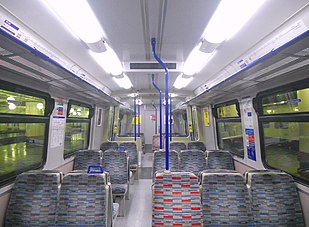British Rail Class 315
class of 61 British 4-car electric multiple units
British Rail Class 315 alternating current (AC) electric multiple units (EMU) were built by BREL at York works from 1980 to 1981. They were the fifth and final variety of British Rail's then-standard 1972 design suburban EMUs, which eventually encompassed 755 vehicles and five Classes (Class 313/314/315/507/508). Like the Glasgow-based Class 314 units, they are only able to operate from 25 kV overhead line current collection. The fleet works inner-suburban services on the Great Eastern Main Line run by the train operating company TfL Rail out of London Liverpool Street. Class 315s also did work services from Liverpool Street to Chingford, Enfield Town and Cheshunt operated by London Overground but got discontinued in 2020.
| British Rail Class 315 | |
|---|---|
 TfL Rail Class 315 at Forest Gate in September 2015 | |
 The refreshed interior of a TfL Rail Class 315 | |
| In service | 1980 – 9 December 2022 |
| Manufacturer | British Rail Engineering Limited |
| Built at | Holgate Road Works, York |
| Family name | BREL 1972 |
| Replaced | |
| Constructed | 1980–1981 |
| Refurbishment |
|
| Number built | 61[2] |
| Number preserved | 1 |
| Number scrapped | 53 |
| Successor | |
| Formation |
|
| Diagram |
|
| Fleet numbers | 315801–315861 |
| Capacity |
|
| Operator(s) | |
| Specifications | |
| Car body construction | Steel underframe with aluminium body and roof |
| Car length |
|
| Width | 2.820 m (9 ft 3.0 in) |
| Height | 3.582 m (11 ft 9.0 in) |
| Floor height | 1.156 m (3 ft 9.5 in) |
| Doors | Double-leaf pocket sliding, each 1.288 m (4 ft 2.7 in) wide (2 per side per car) |
| Wheelbase |
|
| Maximum speed | 75 mph (121 km/h) |
| Weight |
|
| Traction motors | |
| Power output | 660 kW (880 hp) |
| Acceleration | 0.75 m/s2 (2.5 ft/s2)[3] |
| Train heating | Ducted warm air |
| Electric system(s) | 25 kV 50 Hz AC overhead |
| Current collection method | Pantograph |
| UIC classification | Bo′Bo′+2′2′+2′2′+Bo′Bo′ |
| Bogies | BREL BX1 |
| Minimum turning radius | 70.4 m (231 ft 0 in) |
| Braking system(s) | Electro-pneumatic (disc) |
| Safety system(s) | |
| Coupling system | Tightlock[4] |
| Multiple working | Within class |
| Track gauge | 1,435 mm (4 ft 8 1⁄2 in) standard gauge |
| Notes | |
| Specifications as at November 1987[5] except where otherwise noted. | |
References
change- ↑ "News Desk" (PDF). The Railway Herald. No. 125. Northallerton. 21 March 2008. p. 4. ISSN 1751-8091. Archived from the original (PDF) on 9 October 2011. Retrieved 15 July 2011.
- ↑ "PEP-talk: the BR second generation EMU". Rail Express. No. 317. Horncastle: Mortons Media Group. October 2022. pp. 54–55.
- ↑ "Class 315". London: Eversholt Rail. Archived from the original on 3 February 2020. Retrieved 3 February 2020.
- ↑ System Data for Mechanical and Electrical Coupling of Rail Vehicles in support of GM/RT2190 (PDF). London: Rail Safety and Standards Board. 22 June 2011. p. 4. SD001. Archived from the original (PDF) on 1 April 2012. Retrieved 22 November 2022.
- ↑ "Vehicle Diagram Book No. 210 for Electrical Multiple Units (including A.P.T.)" (PDF). Barrowmore MRG. BRB Residuary Ltd. EA207 & EH216–EH217 (in work pp. 16–17 & 286–289). Archived from the original (PDF) on 21 January 2015. Retrieved 21 January 2015.